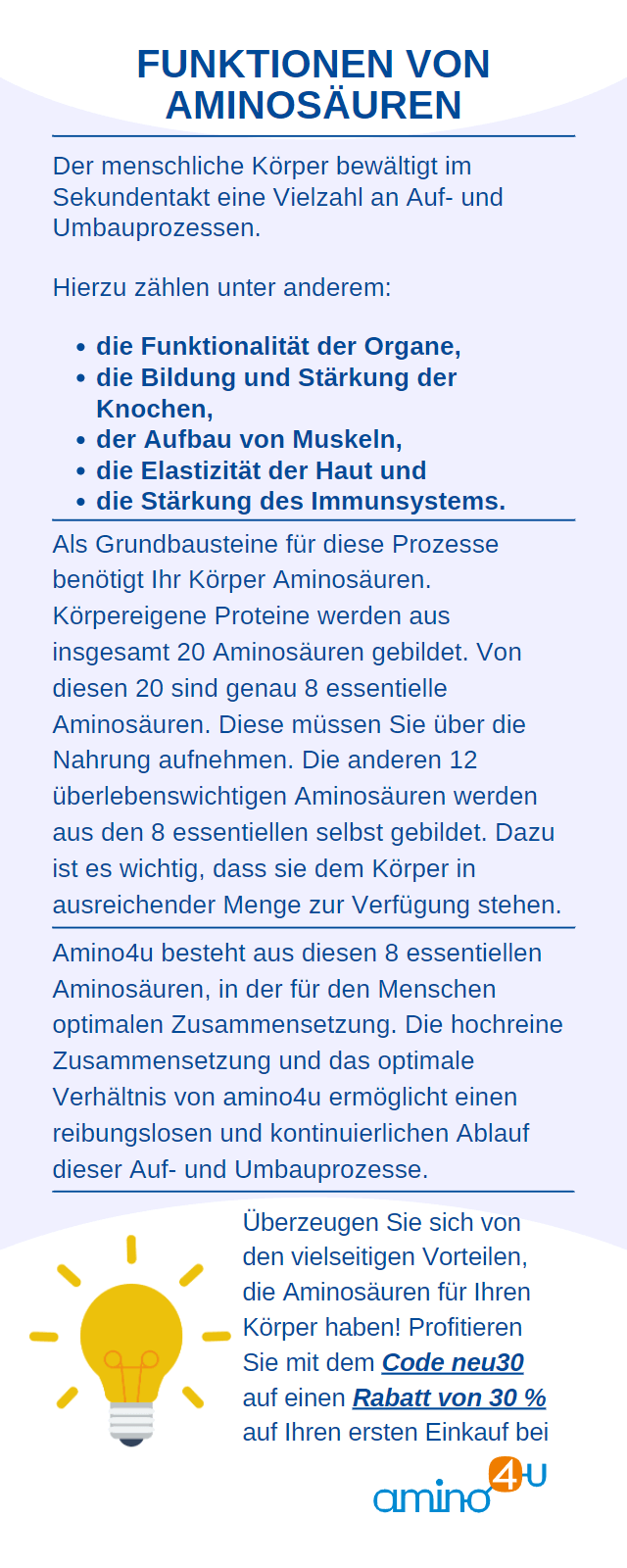Amino acids are nitrogen compounds that serve the organism as building blocks for proteins. Proteins are involved in numerous body functions and are therefore vital. Our body can only partially produce the necessary amino acids itself: so-called essential nitrogen compounds must be supplied with food. Their properties are relevant for the body's functions: There are acidic and basic amino acids.
Since human blood has a pH value of over seven, the corresponding protein building blocks are of particular importance. Because our body wants to keep this value as constant as possible.
To explain: pH values above seven are basic, those below are acidic. A downward deviation from the normal value therefore means that the organism is over-acidified. Nutritionists and naturopaths agree that such
an imbalance in the acid-base balance can affect our health. They therefore advise against an acidic diet.
This particularly affects seniors. Foods with alkaline
amino acids may be able to counteract some of the typical problems associated with old age.
Basic amino acids are:
- Arginine (non-essential)
- Lysine (essential)
- Histidine (semi-essential)
In this article you will find out what they can do and what they do for our body.
Proteinogenic amino acids and their importance
Proteinogenic amino acids are used to build the body's own proteins. There are 20 such protein building blocks in the human genome.
Proteins ingested with food are broken down into individual building blocks via the digestive tract. These are then available to the organism to produce the proteins it needs. How well they can be utilized depends in particular on the protein source and the amino acids they contain.

Division of protein building blocks into three classes
We differentiate between essential, semi-essential and non-essential aminos.
Any amino acid that your body can produce itself in the required amount is called non-essential. The only requirement is an average
balanced diet .
An amino acid is essential when it is essential to consume it through food: the body cannot produce it itself, so insufficient intake inevitably leads to an
amino acid deficiency .
When we are in good health, our body is able to produce semi-essential amino acids from the essential ones. Stress, illness or other unfavorable circumstances can affect this ability. Then the organism also depends on the intake from food.
If a protein source contains all
the essential building blocks in an optimal composition, it is called complete.
For a balanced diet
, the DGE (German Society for Nutrition) recommends that adults consume an average of 0.8 grams of protein per kilogram of body weight per day.
Our age and condition can influence the optimal amount. A combination of plant and animal protein sources is considered balanced.

There is an alkaline environment in the human organism
Our blood normally has a
pH value between 7.35 and 7.44 . It is therefore slightly alkaline, which is ideal for many functions in the organism. The body has its own buffer systems to maintain the alkaline environment as consistently as possible. However, if the amino acid content of the food is generally more acidic than basic, the buffer systems can be overwhelmed.
The
transport of oxygen and nutrients via the blood and thus the entire metabolism suffers from fluctuations.
Specifically, this applies, among other things:
- Electrolyte balance
- Cell supply
- Nervous system as a conductor of stimuli
- Muscle activity
The tasks of the basic amino acids
Our body needs these basic amino acids:
- Arginine (non-essential)
- Lysine (essential)
- Histidine (semi-essential)
A healthy organism produces the amino acid arginine itself. It contributes to the expansion of the blood vessels and thus counteracts clumps and circulatory problems. In addition to your own production, you benefit from arginine in walnuts, peanuts, oats, whole grain rice, poultry, pork and beef.
The organism urgently depends on the
supply of the amino acid lysine. It is particularly involved in enzyme formation and hormone balance, immune stability and tissue regeneration. Lysine is found in peanuts, lentils, soybeans, tuna, shrimp and pork, among other things.
Histidine is used to produce histamine. It is particularly important for immune function and the digestive tract. A healthy adult organism produces histidine itself. The need can also be met through foods such as lentils, wheat germ, salmon and tuna.
Completeness is what matters
Nutritionists emphasize the importance of basic proteinogenic building blocks, as they consider hyperacidification of the organism to be partly responsible for some chronic diseases.
Basically, your body needs
essential amino acids regardless of their pH value.
A balanced diet helps maintain acid-base balance:
The pH value of our blood should ideally be in the range mentioned between 7.35 and 7.44.

The organism's buffer systems compensate for fluctuations
The so-called carbonic acid-bicarbonate system is active in human blood. It stimulates the breakdown of excess acids, which keeps the pH value stable. Hemoglobin, the red blood pigment, is also involved. The acidic substances are broken down into individual components, with the majority being exhaled through the lungs as carbon dioxide. Increased, deep breathing, for example during sporting activity,
promotes the expulsion of acid through the lungs.
Another important buffer system is in the kidneys to excrete acids in the urine. Drink lots of water or unsweetened tea to promote this process. Intestinal activity, muscle activity and sweat secretion also contribute to acid breakdown.
Acidosis - the excess acidity of the body
We differentiate between acute metabolic and latent acidosis. The risk of latent acidosis arises if we eat a diet that is too acidic in the long term. If the acidity of the food is permanently too high, the
body's buffer systems may no longer be sufficient.
Latent means that the pH value of the blood has shifted slightly to an acidic environment. This means that our bodily functions can still be maintained overall. On the other hand, a balanced supply of the cells with all the necessary nutrients is no longer guaranteed. Overall, latent hyperacidity leads to our material transport and metabolism being impaired in the long term.
Due to the increased acid excretion via the kidneys, latent acidosis can be detected by a low pH value in the urine.
The body's own buffering of acids relies on
minerals and a basic amino acid is usually richer in minerals than an acidic one. This means that the body needs more minerals when there is latent acidosis. However, we receive fewer of these substances if we eat a predominantly acidic diet. To regulate the mineral balance, alkaline foods are increasingly recommended.
Purely diet-related acute metabolic acidosis is quite unlikely: This involves a more rapid
shift of the pH value into the acidic range. Our body's buffer systems normally prevent this.
The cause may be chronic kidney failure, which impairs acid excretion. Diabetic coma is another risk factor.

Basic amino acids and acid-base behavior
It is a common misconception that a person simply needs to consume a lot of protein-containing foods to ensure a balanced diet. It depends on the protein quality - more precisely on the amino acid composition.
In order to be able to
utilize them optimally in the body , high bioavailability is advantageous. All relevant building blocks for the body's important proteins must also be included. This applies especially to essential and possibly
semi-essential amino acids as well as those of a basic nature.
The views of nutritionists and practical tips on food composition are not always consistent.
The “
Potential Renal Acid Load ”,
or PRAL for short, is scientifically recognized. This value indicates the acid excretion of individual foods via the kidneys and thus the acid load on the body. A negative PRAL value indicates an excess of base, a high value indicates an excess of acid.
Since the body's own buffer systems work on an alkaline basis and alkaline foods have a deacidifying effect, the following applies: acidic foods contribute to the consumption of alkaline reserves.
However, sour does not refer to the taste, but to the chemical properties!
Pay attention to individual constitution and nutrient quality
The PRAL value alone is still inadequate as a guideline.
Other factors play a role in the actual acid-base balance and the right diet:
- If you are regularly active in sports, excess acid is increasingly broken down through breathing and muscle activity.
- Drink plenty of fluids, preferably water, to support acid breakdown via the kidneys.
Older people, who are naturally more prone to bone loss, have a less active buffer system than young people. According to the Association for Independent Nutrition (
UGB ), you should eat more alkaline nutrition.

How a balanced diet has a positive effect on us
Studies confirm a connection between the acid-base balance and osteoporosis, informs the UGB: Even a slight, long-lasting
level of acidification promotes the breakdown of bone substance .
This is due to the loss of minerals that the body obtains from the bones, among other things, to excrete acid.
The cartilage structure and the connective tissue as a supporting structure can also be affected.
The UGB also explains: As early as 2004, the World Health Organization (WHO) and the Food and Agriculture Organization (FAO) confirmed that bone loss and the associated disruption of the calcium balance are linked to protein intake. That's why they recommend enjoying acid-forming foods in moderation. This also applies to rheumatism and gout diseases, which are associated with increased acid excretion.
Do you eat a predominantly alkaline diet?
These findings are likely to be of particular interest to older people: A balanced diet to regulate the acid-base balance could counteract typical ailments in old age such as osteoporosis.
WHO and FAO therefore recommend reducing the consumption of acid-producing foods such as meat.
In addition to osteoporosis, this could have a positive effect
on other symptoms :
- Cardiovascular disorders
- high blood pressure
- Connective tissue weakness
- Muscle loss
- Circulatory disorders
The connection has not yet been scientifically clarified. However, nutrition researchers agree that a constant pH value is important for regulating body functions. It should always be slightly basic. They therefore recommend consuming
foods containing basic amino acids .
This is particularly true if latent acidosis is already known and with increasing age when the risk of certain diseases increases. As a guideline for a balanced ratio, nutritionists often specify around two thirds of basic or
plant-based amino acids . We are allowed to incorporate one third of acidic or animal amino acids into our diet.
If you want to
eat healthily , just pay attention to it
- reduce meat consumption,
- Limit alcohol and sugary foods and
- Consume fresh vegetables and fruits regularly.
If you learn to deal with stress better, exercise regularly and drink enough, you will also contribute to a balanced amino acid metabolism.








